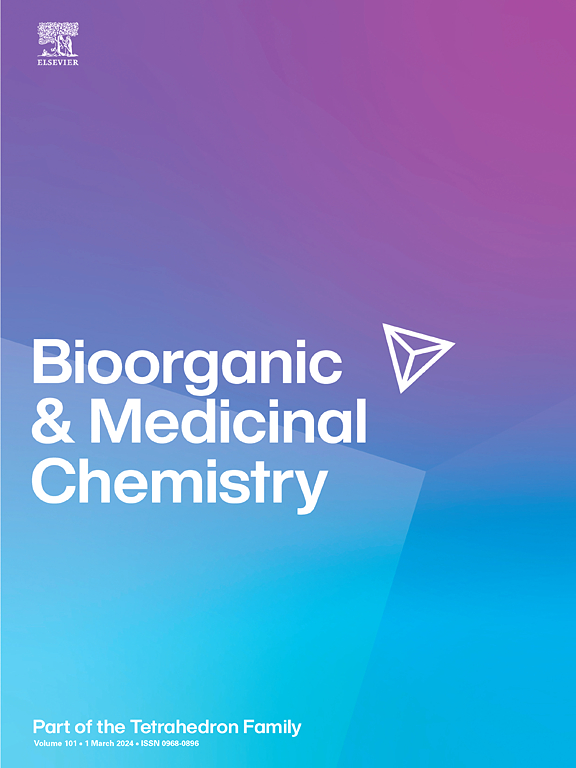Discovery of a potent C20-oxime pachysandra alkaloid analogue promising for treatment of hepatocellular carcinoma
IF 3
3区 医学
Q2 BIOCHEMISTRY & MOLECULAR BIOLOGY
引用次数: 0
Abstract
The Miao medicine “Sanliangyin” is derived from the root of the Sarcococca ruscifolia (genus Sarcococca, family Buxaceae), which has been commonly used in Miao regions to treat malignant tumors. Previous research by our group has identified pachysandra alkaloids as the primary active ingredients in this plant, which exhibited anti-tumor properties. However, the low structural diversity and moderate activity of the isolated alkaloids hampered their clinical application. One of the effective strategies to address these challenges is the introduction of bioactive pharmacophores, leading to the development of natural product-pharmacophore hybrids (NPPH) with enhanced drug properties. To the best of our knowledge, oxime groups that introduced into natural products usually have enhanced the anti-cancer activity. Therefore, to develop more potent pachysandra alkaloid analogues with low toxicity, we synthesized a series of derivatives (7a-7 g) to increase their structure diversity by introducing various anilines at C-3 and oxime at C-20 positions of epiandrosterone. Using the CCK-8 assay, we found that the IC50 values of the pachysandra alkaloid derivatives against HepG2 liver cancer cells ranged from 0.127 to 1.536 μM. Further evaluation on THP-1 cells showed that, at a concentration of 12.50 μM, the cytotoxicity of the seven compounds ranged from 46.06 % to 100.00 %. Based on cell viability and cytotoxicity assay, we found that compound 7a exhibited the strongest activity against liver cancer cells while showing the lowest toxicity. Network pharmacology and molecular dynamics simulation studies revealed that compound 7a had a strong correlation and good binding affinity with the JAK2/STAT3 signaling pathway. Further mechanism studies have shown that compound 7a could inhibit migration, induce mitochondrion-mediated apoptosis, thereby suppressing cell proliferation in HepG2 cells through regulation of Bcl-2 family proteins and the JAK2/STAT3 signaling pathway.

发现一种有效的c20 -肟类球孢生物碱类似物,有望治疗肝细胞癌
苗族药“三良饮”是由花椰菜(花椰菜属,豆科)的根提取的,在苗族地区常用来治疗恶性肿瘤。本课题组前期研究已鉴定出pachysandra生物碱为该植物的主要活性成分,具有抗肿瘤作用。然而,分离得到的生物碱结构多样性低,活性不高,阻碍了其临床应用。应对这些挑战的有效策略之一是引入生物活性药效团,从而开发具有增强药物特性的天然产物-药效团杂种(NPPH)。据我们所知,引入天然产物的肟基通常具有增强抗癌活性的作用。因此,为了开发更有效、低毒性的pachysandra生物碱类似物,我们合成了一系列衍生物(7a- 7g),通过在表雄酮的C-3位置引入各种苯胺和C-20位置引入肟来增加其结构多样性。CCK-8实验结果表明,重山生物碱衍生物对HepG2肝癌细胞的IC50值为0.127 ~ 1.536 μM。进一步对THP-1细胞进行评价表明,在12.50 μM浓度下,7种化合物的细胞毒性范围为46.06% ~ 100.00%。通过细胞活力和细胞毒性实验,我们发现化合物7a对肝癌细胞的活性最强,毒性最低。网络药理学和分子动力学模拟研究表明,化合物7a与JAK2/STAT3信号通路具有较强的相关性和良好的结合亲和力。进一步的机制研究表明,化合物7a可以通过调控Bcl-2家族蛋白和JAK2/STAT3信号通路,抑制HepG2细胞的迁移,诱导线粒体介导的细胞凋亡,从而抑制细胞增殖。
本文章由计算机程序翻译,如有差异,请以英文原文为准。
求助全文
约1分钟内获得全文
求助全文
来源期刊

Bioorganic & Medicinal Chemistry
医学-生化与分子生物学
CiteScore
6.80
自引率
2.90%
发文量
413
审稿时长
17 days
期刊介绍:
Bioorganic & Medicinal Chemistry provides an international forum for the publication of full original research papers and critical reviews on molecular interactions in key biological targets such as receptors, channels, enzymes, nucleotides, lipids and saccharides.
The aim of the journal is to promote a better understanding at the molecular level of life processes, and living organisms, as well as the interaction of these with chemical agents. A special feature will be that colour illustrations will be reproduced at no charge to the author, provided that the Editor agrees that colour is essential to the information content of the illustration in question.
 求助内容:
求助内容: 应助结果提醒方式:
应助结果提醒方式:


